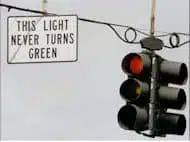Letting go of the belief that the way you see things (the story you tell yourself) is either real or true is difficult–it’s the hardest lesson. It is when reality conflicts with the story, however, that a real opportunity for growth and shifting occurs.

Want to learn more about living a full and meaningful life?
Want to have the best relationship ever?
Check out my books
Given how 2020 went, a lot of people are questioning their beliefs, their goals, and their place in the world.
Or better, many are afraid of “what’s out there„, what’s next. So I decided to take this opportunity to discuss letting go, and “What’s going on.”
On both a theoretical and practical level, the only thing “going on” is what’s going on in you.
This is not an ego-driven statement — not meant to suggest that “your” way is the “right way.”
A client said, “Sure, we could get on the same page, so long as it’s her page.” This is NOT what I mean.
I used to tell my clients that the hardest thing they’d ever have to accept is precisely this:
What goes on for you, inside, is all you. All the time.
Not true, not real. Just your story. So the big question is, is your story helpful, or useless?
We make comments to ourselves all the time
You can call the internal comments your story, or your narrative. It’s not true — it’s made up of fragments of experience, strung together like beads. You chose which things to notice (and add to the narrative) based on the story itself.
Our stories, left to themselves, are self-fulfilling prophesies.
Mostly, we have quite judgemental stories going on in there — most of us would never talk to another person the way we talk to ourselves. But somehow, we trot along, framing our lives through ridiculous narratives, until a difficult situation upsets our applecart.
The Glitch and Letting Go
Here’s a quote from a book called Language Structure & Change, by Efran, Lukens and Lukens, in a section entitled “The Meaning of Psychotherapy.”
In therapy, two or more individuals meet and form a novel coupling that enables them to carve out new distinctions. In the process, as we have noted, they breathe life into alternatives that had no previous existence. At its best, psychotherapy begins with a particular “glitch” in a client’s life and moves towards redefining and expanding the possibilities of living. (pg.197)
Our lives are made up of the “stories we tell ourselves.”
This idea comes from narrative therapy, which suggests that change comes from letting go of an inelegant story and replacing it with a more useful one — the “new distinction” of the above quote.
The “glitch” is the point we all reach when the story we are telling ourselves can no longer contain the present reality. At that point the choices are two:
- Trying to force the new experience onto the “old page,” or
- letting go by writing a new page.
“When I look at our situation ‘objectively,’ I recognize it’s all your fault.”
The norm is to “judge the glitch.” Interior work is difficult — pointing a finger at the situation or the “other” is easy. A “cloak of objectivity” is thrown over the situation. “Why can’t you see this?”
Answer: they’re not you, and they have another story.
Let me give you an illustration.

“Sue” was widowed at age 35. Here is her reality: she was married for 10 years, and then her husband died.
Her internal theatre — her story, however, was not that simple.
Rather letting go of that story and writing a new one–perhaps a “Here I am, starting over,” story, she chose to try to maintain her old story (married woman) and also added in two other roles (widow, single woman.)
In her head, she was playing three characters — three wildly different characters–each with their own agenda.
- there was the baseline, “married woman,” who wanted everything to be the way it was — she called this her “white picket fence story.”
- there was the grieving widow, whose default is “helpless, lonely, horny, in need of a shoulder to cry on, likely forever.”
- she was (in reality…) a single woman looking to have sex, date, flirt, have more sex.
As she had not shifted her internal theatre to match her new reality, the three characters were at war. They each had their own agenda, and there was nothing but confusion.
Here’s what happened, as she attempted to re-enter the world:
“The widow,” needed to be held and comforted by a man. She had never learned how to arrange for this with her male friends, so she met her need through barter.
“You hold and comfort me, I’ll return the favour with sex.” Since she thought she’d be grieving forever, she expected a long line of strange men to enter her life — as she bartered away her soul.
“The single woman” thought having sex was quite OK–she loved sex–but interestingly the single woman also had a trick up her sleeve. She only wanted to have sex with men who wanted a relationship that would lead to marriage. If she discovered (after the fact) that the person was not “into” marriage, “part of her” would declare that her latest round of casual sex was “wrong.”
“The married woman” popped into the equation, loudly expressing the opinion that, when “the single woman” had sex, she was cheating on her (dead) husband. So, she’d kick each guy to the curb before anything “serious” could happen, and crossed her legs. Tightly.
That is what a Glitch looks like

“Objectively,” pretty simple. “Sue” wanted to be held. The “glitch” arose when the widow and the married woman showed up on the single woman’s date.
Sue was trying to achieve something that her current story–her current self-definition–had no room for.
It was not her actions that were blocking her — it was her interpretations — the story she told herself — that got her into a pickle.
So, what did “Sue” do? She wailed, “It’s not fair! I shouldn’t have to deal with this!”
Nice, except that present reality is what it is.
Our work in therapy was to peel back the layers of her story. We explored how, by letting go, Sue might “be,” right here, right now, as “it” is.
Now, let me hasten to add that the goal of therapy (and life!!) is not to find the true story.
There is no true, “objective” reality. All there is is whatever story you are telling yourself — your story, and whether it’s useful or getting in your way.
If your life seems stuck, you must change your story by letting go.
Here’s a bit about how this works in a relationship:
A quote from Snow Crash, by Neal Stephenson. Let me set the scene for the quote.
The main character is a computer programmer named Hiro. In this quote he’s talking to a 15-year-old pizza delivery girl, Y.T., about his ex girlfriend — Hiro’s hoping to get back together with her.
We pick it up on page 409.
Y.T. says, “Did you hook up with your old girlfriend yet?”
Hiro: “No, but I have high hopes for that. Assuming I can stay alive.”
“High hopes for what?”
“Our relationship.”
“Why?” she asks. “What’s changed between then and now?”
This is one of those utterly simple and obvious questions that is irritating because Hiro’s not sure of the answer.
“Well, I think I figured out what she’s doing — why she came here.”
“So?” Another simple and obvious question.
“So, I feel like I understand her now.”
“You do?”
Yeah, well, sort of.”
“And is that supposed to be a good thing?”
“Well, sure.”
“Hiro, you are such a geek. She’s a woman, you’re a dude. You’re not supposed to understand her. That’s not what she’s after.”
“Well, what is she after, do you suppose …?”
“She doesn’t want you to understand her. She knows that’s impossible. She just wants you to understand yourself. Everything else is negotiable.”
(emphasis mine)
Again, it’s about letting go by figuring yourself out
A client reported 10 failed relationships in the past few years. He said, “I could always find something wrong with each of them. I’d wait for them to change, but they never did.”
My question was, “Wrong in comparison to what?”
Of course, the answer was simple. Wrong, in terms of who he thought they should be. Wrong, in terms of not meeting his fantasies.
I asked him what he did about the behaviours he thought were “wrong.” Did he talk with the woman about his concerns? He replied, “No. I go home and analyze the situation.”
I wondered aloud if he, as a part of his analysis, did the following: he first pictured his girlfriend engaged in the problem behaviour, then saw himself interacting with her, and then realized she’d never change. He said that this was precisely what he did, and that this made him sad, as he’d have to leave her.
He was stunned when I suggested to him that the entire process he was engaged in was simply him talking to himself.
His girlfriend is not in his head. The person in there is him, in drag, playing the role of his girlfriend.
Back to the idea of “objectivity.”
We desperately want to believe that we have infallible memories and make totally impartial judgments. In “truth,” our “memories” change all the time and are extremely inconsistent and unreliable. And our judgments are all about making what we see fit what we expect to see.
When we experience another’s actions, we don’t simply experience the event. We interpret it.
This means we make a judgment about their intent.
“She’s looking at me like that (the experience) because she hates me. (the judgment).”
What we’re doing is looking at the screen inside our heads, punching the “match expression” button, and in the blink of an eye, we’re looking at similar expressions, to which we have already attached meaning.
Each of those events, however, are in our memory bank because we placed them there using the same process.
Typically, the judgement and then the connection was made internally, without ever checking with the other person.
Another part of the “internal judgment” process is observing another’s behaviour and thinking, “What would I mean if I did that?”
Lets take an example. Stanley yells as Susie enters the room. Susie goes inside and instantly realizes she yells in that tone when she’s angry.
She replies, voice on edge, “Stop yelling and tell me why you’re angry with me.” Stanley looks confused. He says, “I wasn’t yelling at you, and I’m not angry. I’m frustrated that this light switch won’t work.”
Susie says, ” I hate it when you yell at me and won’t admit you’re angry.”
We all know where this is going.

My first and most popular book,
This Endless Moment.
Learn to live a full and satisfying life.
To get back to the Snow Crash quote: What an amazing world it might be if we stopped trying to figure everyone else out, (internally, of course, without asking the other person) and simply concentrated on letting go and figuring ourselves out.
Y.T. is right. The wise soul simply observes what she is doing, and in that process get to know herself. Everything else is negotiable. From a place of self-knowing, there can be an invitation to dialog, to sharing, to admitting what we’re doing.
Imagine what might happen if you say,
“So, I’m confused. I just saw you do (whatever) and I went inside and judged that you were (whatever) and I notice that I’m scaring myself (or making myself angry, or I’m getting ready to leave, whatever) and I’m wondering what’s going on for you?”
You will notice that the language is “I” language.
The person speaking is reporting her experience. She is admitting to the judgments she is making as she pretends to understand what the other person “meant.”
Having done that, and here is the mark of wisdom, she also admits that she doesn’t have a clue as to what is going on for the other person, so she asks.
Now, she may discover that her perception and judgment were accurate. By asking what is going on for the other person, however, she has moved from a “You did too!” “I did not!” kind of confrontation to an invitation for her partner to explore what is going on for him.
In the end, we are self-defining creatures.
We create our reality through our stories — and do so all the time. As does everyone we come in contact with. And then we pretend we “understand.”
The key to a successful, wisdom-filled life is to admit the existence and prevalence of our fantasies. We live in a world we create; we establish the rules and the boundaries, and then we try to make others play by our rules. And all the time, they’re doing the same to us.
This is what the authors of Language, Structure and Change are getting at. Note the idea of “expanding possibilities.” They mention “alternatives that had no previous existence.”
They are suggesting, as am I, that far from there being limited choices in life, the limitations we find ourselves confronting are constructions, determined in advance by the stories we tell ourselves. Or, as the expression goes,
“Argue for your limitations and they are yours.”
We have the potential, in dialogue, to examine and re-examine the stories of our life. We can listen to what we tell ourselves, how we describe our situation, and we can understand that, far from seeing our lives objectively, we see them “objectively,” and find ourselves living self-fulfilling prophecies that are limiting and limited in the extreme.
Stuart Wilde coined the term “fringe dwellers” for those who understand about “objectivity” and personal responsibility.
Self-responsible fringe dwellers don’t try to change others. They observe and change the stories they tell themselves.
Experiment with waking up to your own stories, determining what you believe and how you act — wake up to how you limit yourself.
We encourage you to find “alternatives that had no previous existence.”
And then, drop us a comment and tell us about it!
